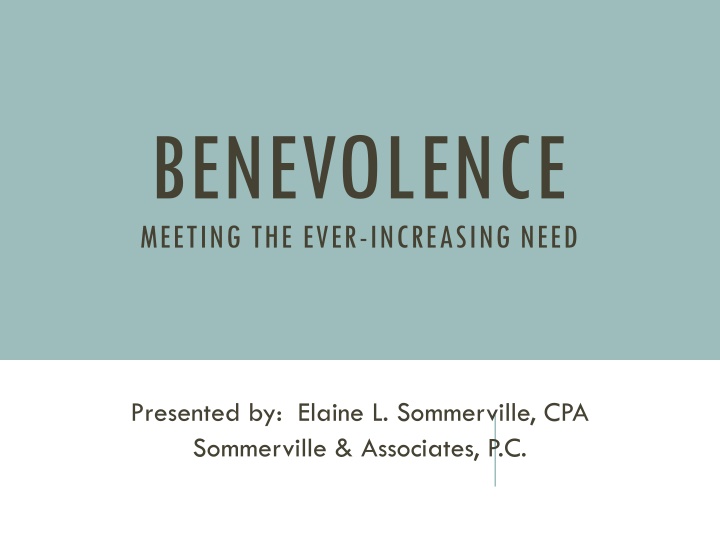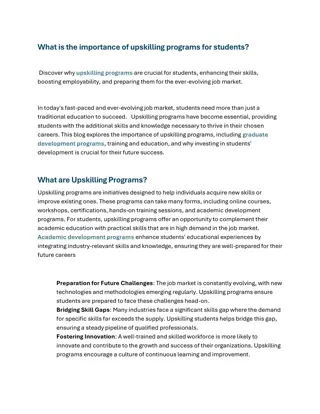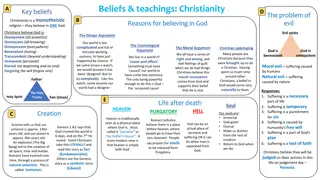Meeting the Ever-Increasing Need for Benevolence Programs
Delve into the requirements and concepts essential for running successful benevolence programs, including understanding benevolence, documentation and reporting needs, differences in providing benevolence to employees and non-employees, concepts of charitable class, taxation aspects, and qualifying criteria for benevolence assistance.
Download Presentation

Please find below an Image/Link to download the presentation.
The content on the website is provided AS IS for your information and personal use only. It may not be sold, licensed, or shared on other websites without obtaining consent from the author.If you encounter any issues during the download, it is possible that the publisher has removed the file from their server.
You are allowed to download the files provided on this website for personal or commercial use, subject to the condition that they are used lawfully. All files are the property of their respective owners.
The content on the website is provided AS IS for your information and personal use only. It may not be sold, licensed, or shared on other websites without obtaining consent from the author.
E N D
Presentation Transcript
BENEVOLENCE MEETING THE EVER-INCREASING NEED Presented by: Elaine L. Sommerville, CPA Sommerville & Associates, P.C.
OBJECTIVE To understand the requirements for operating a successful benevolence program In this session you will learn What is benevolence? What are the documentation requirements for a benevolence program? What are the reporting requirements for a benevolence program? How does benevolence to employees differ from benevolence to nonemployees?
WHAT IS BENEVOLENCE? According to www.dictionary.com benevolence is: The desire to do good to others Goodwill An act of kindness; or A charitable gift In churches and other nonprofits, we find that a benevolence program is a program established to identify and meet the needs of individuals that they cannot meet themselves.
THE CONCEPT OF CHARITABLE CLASS Exempt programs must serve a charitable class to prove exempt purpose and not private benefit The class must be either indefinite or of a sufficient size PLR 201205011 & 202113009: group benefiting too small not acceptable The poor and distressed or underprivileged are a charitable class. Other examples include, children, the elderly and victims of certain disasters.
Gifts IRC Section 102 General taxation of benevolence paid to individuals is that it is a gift to them and is not taxable. May not be provided to employees due to the limitations under IRC Section 102. TAXATION OF BENEVOLENCE Qualifying Disaster Relief IRC Section 139 Special programs for areas covered by a presidential disaster declaration May include employees See https://www.irs.gov/charities-non- profits/charitable-organizations/disaster-relief- resources-for-charities-and-contributors for two webinars available from the IRS
QUALIFYING FOR BENEVOLENCE A qualifying benevolence is one that Is provided to a member of a charitable class there is a need - need equals necessity Necessity normally includes items such as food, clothing, shelter, transportation and health care. that need cannot be met by the recipient from resources currently available to them Example: even though someone has financial resources, if they are not available for use at that time, they may still qualify for assistance.
For a program to not threaten the exempt status of the organization/church, it must operate according to a formal structure that documents the recipient s qualifications for the program. STRUCTURE OF A BENEVOLENCE PROGRAM Example: Church in Boston argued that its grants and assistance to the poor supported its exempt purposes, but the lack of proper documentation as to the selection criteria and the purpose of the grants lost the church its exempt status. Program was deemed to be a substantial non-exempt purpose.
A method of verifying the person is a member of a valid charitable class (generally requires an application in addition to a potential interview with the applicant.) This step is crucial since it is the documentation that will: support the church s decision to make the payment; prove that the payment is within the guidelines established by the church; and prove that the payment fulfills the church s exempt purposes. SUCCESSFUL PROGRAMS WILL CONTAIN:
SUCCESSFUL PROGRAMS WILL CONTAIN: Guidelines that allow staff to operate the program: a. Who has the authority to authorize what; b. What types of needs will be considered; c. What type of third-party confirmation will be required; d. What proof of other resources will be obtained; e. Who is the targeted group; f. What will disqualify a candidate; g. Will the applicant have to do something for the assistance; h. How will the need be met; i. How will multiple requests be handled; j. How will requests from employees and their family members be handled; and k. What is the process for making a request. A manner of reviewing the above information by persons independent or disinterested from the person making the request.
SPECIAL CONSIDERATIONS OR OBSTACLES
Discretionary Funds Can create taxable income to the holder of the funds Tend to be used to protect privacy issues Discretionary Funds should DISCRETIONARY FUNDS Be limited to being used for valid business expenses Be documented under all church standards Be processed through the church s regular accounting processes Not be used as an end run around the policies of the church This type of benevolence assistance should be very small amounts; i.e., a tank of gas or a small amount for food.
Be Prepared Have a plan before they occur Take the following steps: 1. Have the appropriate committee approve the situation; 2. Perform regular reevaluations of the situation to document that the need continues to exist; and 3. Assist the recipient in exploring other sources to meet a continued need. REPEAT REQUESTS
DESIGNATED GIFTS A church cannot accept a contribution that is earmarked for an individual, even one with a need, and pass it through outside of the normal processes of the church. The church is allowed to solicit the congregation for additional funds for benevolence funds due to an unusual situation, if it is clearly conveyed that the church is the one making the final determination as to the amount of assistance that any recipient will receive. Clearly have a church policy that says that designations are just considered as suggestions
Internal Revenue Code Section 102 specifically states that the gift exclusion is not available to amounts paid to an employee. EMPLOYEE BENEVOLENCE These situations will fall into one of three categories: Assisting employees that are not a part of management Assisting employees that are a part of management Assisting the family members of employees
REGULAR EMPLOYEES It is not possible to provide benevolence assistance to an employee without adding it to taxable income. If necessary, then it should be approved as additional income. This income is also subject to employment taxes if the employee is not a minister. Result a benevolence given to an employee is taxable
EMPLOYEES CONSIDERED AS DISQUALIFIED PERSONS Certain employees are disqualified persons. These are generally persons in decision-making positions A disqualified person may never receive a payment that is outside of reasonable compensation or that has not been properly approved A payment given outside of this procedure is subject to repayment and a potential penalty of 25% to 200% Result a benevolence given to a disqualified person, even if taxed, can be subject to repayment and a penalty if not properly handled
Considered to be income to the employee, if the employee is responsible for the care of the family member FAMILY MEMBERS OF EMPLOYEES There are times that the relationship may not trigger income to the employee if the employee is not a disqualified person.
FAMILY MEMBERS OF DISQUALIFIED PERSONS If it is the duty of the disqualified person to care for this family member, then he/she may not use the church to fulfill their moral and/or legal obligation Example: Pastor Ed is a member of the board and considered to be the President of First Church. He is also compensated for his duties as senior pastor. Pastor Ed s mother has medical expenses that she needs assistance in paying. What factors should be considered in considering a benevolence request for the mother s medical needs?
IRC Section 139 Created a form of approved charitable class for disaster relief work QUALIFYING DISASTER RELIEF Qualifying disasters Terrorist action Accident involving a common carrier Presidentially declared disaster area Other IRS declared areas
EXCEPTION UNDER SECTION 139 Payments received for assistance as a result of a qualifying disaster will be excluded from the income of the recipient. Employees Family members of employees Major donors Note: while this may assist in some instances with disqualified persons, it has not been construed to automatically alleviate intermediate sanctions on officers, directors, or those members of the selection team.
Presented by: Elaine L. Sommerville, CPA Sommerville & Associates, P.C. THANK YOU! www.nonprofit-tax.com elaine@nonprofit-tax.com www.elainesommerville.blogspot.com























